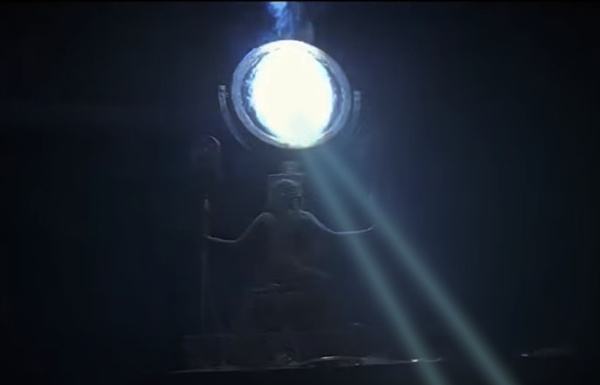Steinmusic H2 ROOM AcousticS System
The Steinmusic H2 system is - if correctly dialed in - beyond any description. It needs to be experienced to fully appreciate its power. No, it won’t replace proper acoustic treatment, and you will still need to address the room modes and reverberation through good old absorbers and diffusers, or their equivalents. However, let’s put it straight: As soon as the room’s acoustics is satisfactory, the Steinmusic devices have the power to transform the listening space to the point you’ve never dared to dream of.
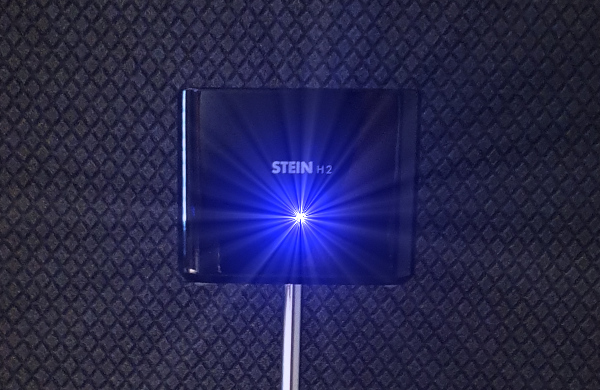
A web of lights
There is a lot of reviews out on the H2 Room Acoustics package. So many, that I feel that I am the last one in the audio world who’s had the opportunity to test it. True, there is no distributor in the country of my residence, and that explains the thing a bit. So, at this point, I am very grateful to Sebastian Stein who organized a shipment to my doorstep and allowed me to spend three months with it.
When I say H2 Room Acoustics System I mean several devices by that, active and passive, that are highly complementary. The base of the system was conceived some 12 years ago, and since then the range has expanded and got improved. For it is a learning curve both for the listeners and the manufacturer, the process of upgrades continues. It is safe to say that the H2 system of today is a combination of Steinmusic H2 Harmonizers, Black Stones, Blue Diamonds, and Blue Suns.
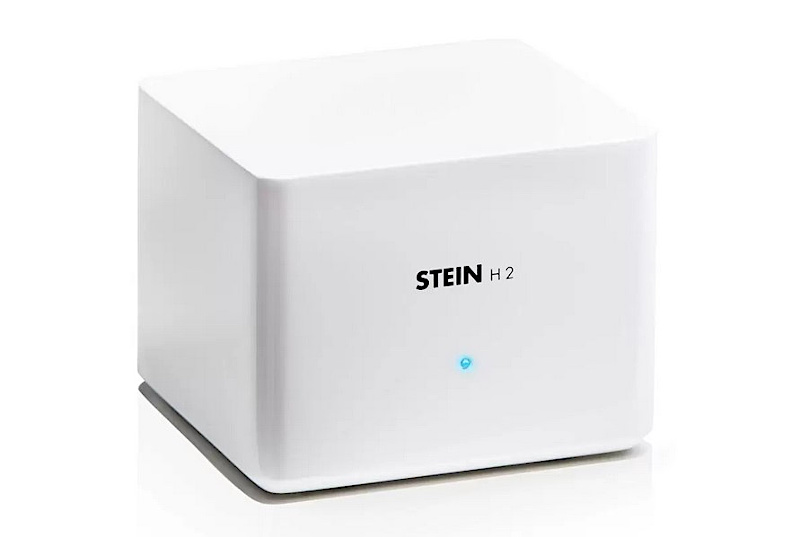
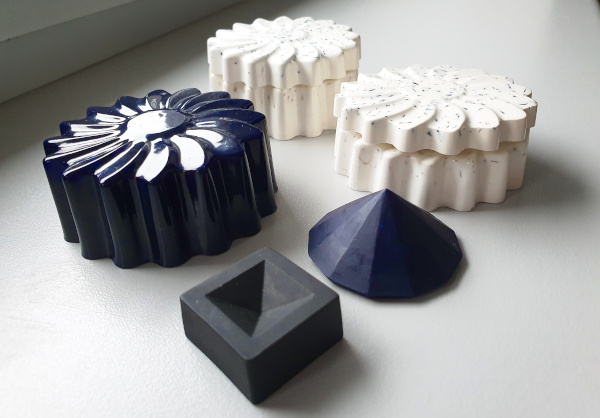
The H2 Harmonizer is the only device that requires an electric energy source. It is jewel-box sized enclosure with immaculate piano black (or white) finish, and with a single blue LED on its front panel. On its rear panel there is a switch that toggles between active – active with LED on – inactive modes, and a single knob that regulates the intensity of whatever the Harmonizer does. The Harmonizer is powered by four AA batteries, and optionally comes with a nice stainless-steel stand. The other option is to use a supplied bracket to attach to the wall at appropriate height. The H2 Harmonizers come in pairs that combine two units, clearly marked as “a” and “b”. This combination is necessary for the Harmonizers to work properly. I can confirm it, as I learnt it through my own mistake in the review process, as you will read further.
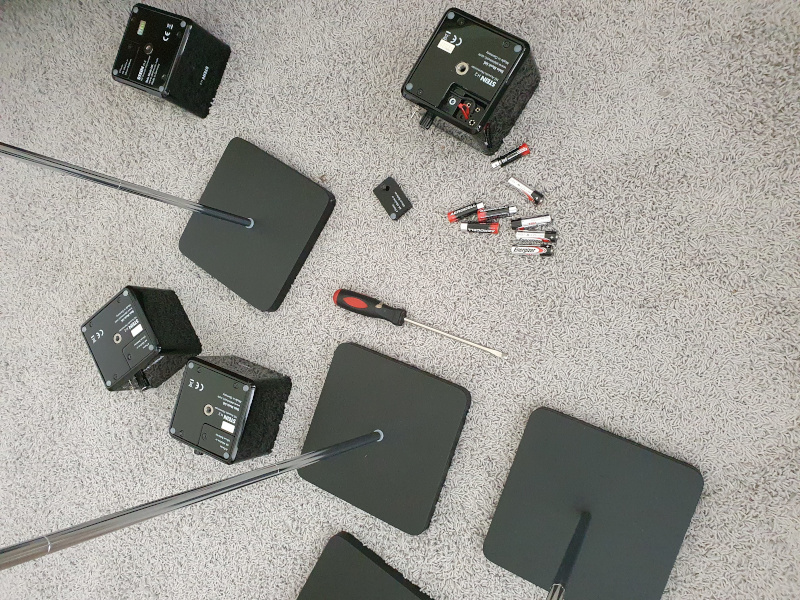
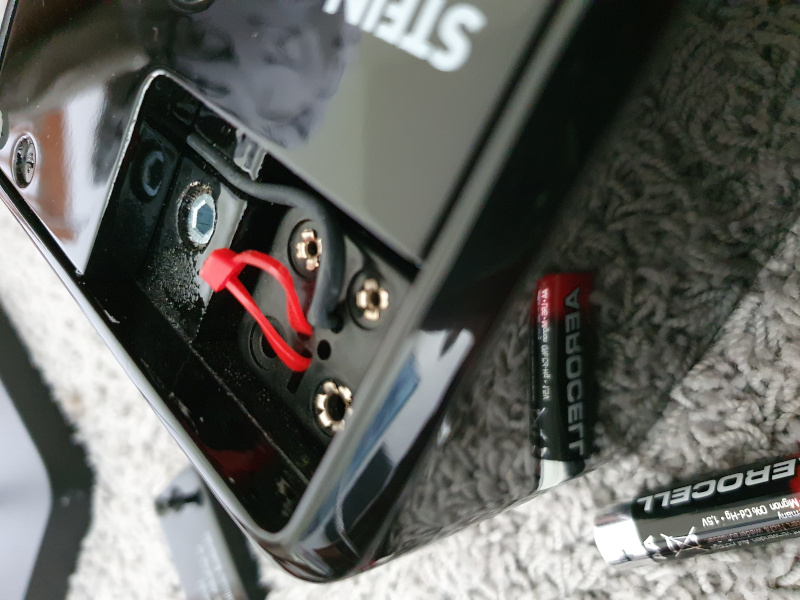
The other devices are passive. Maybe it is not the right word, because they are definitely transacting some sort of an energy, but they don’t have a power source in them. All are cast from a resin and loaded with powdered minerals, a unique blend in each. The Black Stones are small black rectangular pieces that look like imploded pyramids, the Blue Diamonds are shaped like diamonds, and the Blue Suns, guess what, are shaped like suns. These devices are deep blue and creamy white, depending on what you choose. Over the last years different variants of the Suns have been marketed, differentiated by their thickness (and the strength of their effect).
For this review I received two H2 Harmonizer pairs with stands, and a large box full of the Stones, Diamonds, and Suns, most marked by a hologram saying ´Signature´ version.
The passive devices
How do the Stones, Suns and Diamonds compare to what I experienced with Synergistic Research’s HFTs and ASI’s Sugar Cubes? These devices have the same mission and there are many similarities, although I identified few major differences too.
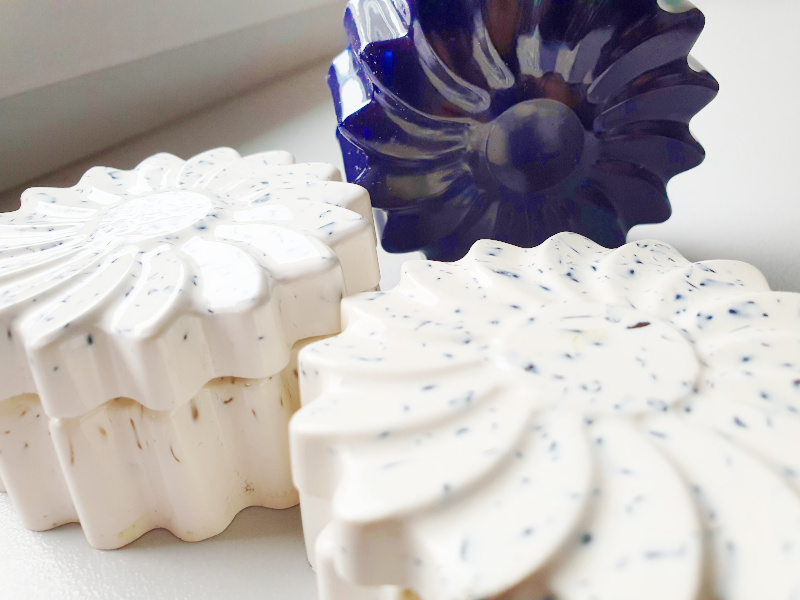
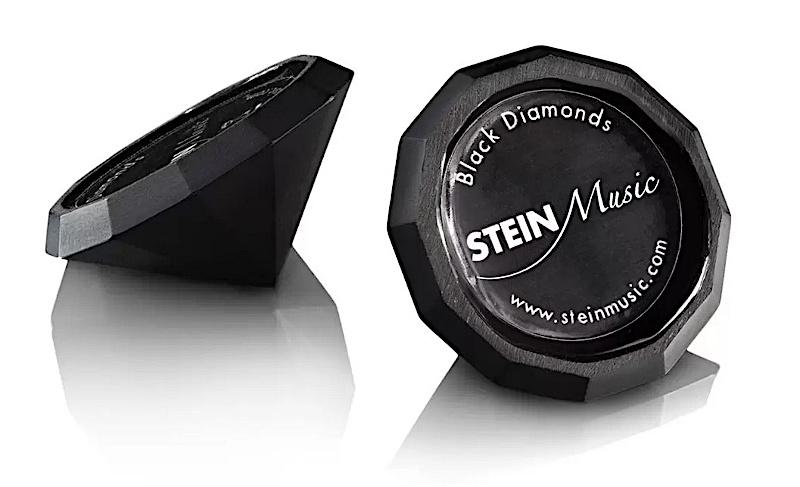
All are sensitive to the right placement. It means that when you hit the right spots with them, you will immediately hear it. But there is always a sweeter spot within the sweet spot. The one that elevates the experience from the great to the absolutely superb. The difference is that with the Steinmusic devices the process of finding the sweetest spots is much faster and more fun. Whilst the Synergistic Research’s and ASI’s room elements are hyper-sensitive to the placement and working with them is a chore, the Steinmusic devices are more forgiving. It means a placement freedom of centimeters rather than millimeters, yet the result is not less amazing.
Steinmusic provides a manual that will guide you through the set up. My own experience with the devices says that following the manual’s recommendations is necessary if you don’t want to end up wandering around the room and wondering why you hear no improvement. Some placements are more intuitive, some are contra-intuitive – you will make your life easier to follow the Steinmusic’s suggestions, and then feel free experiment in the proximity of the locations. Here’s the reprint of the set up that will work for 99% of the rooms:
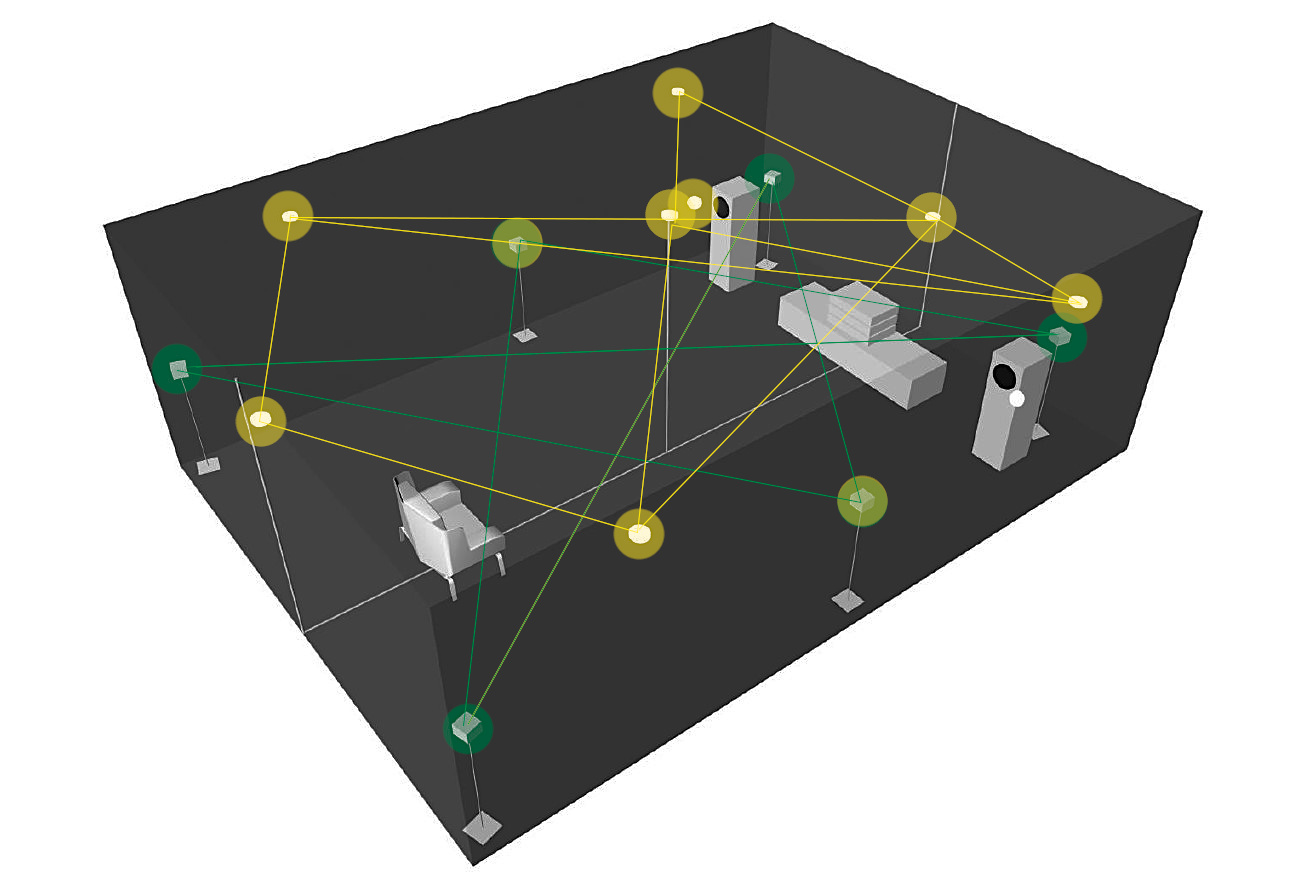
It is not necessary to go full-throttle with the Steinmusic as in the picture, however I recommend going as full-throttle as you can afford. Two Suns will not do much in the room, and if you are really serious about removing the room’s walls, you will need more than the two.
A remarkable (and unique) attribute of the Steinmusic devices is that they can be stacked. Thus, a Blue Diamond can be secured atop a Blue Sun, or two Suns can be stacked. For each of the devices has different functionality, the right combination will produce even higher level of the sound openness and textural clarity, or expand the holography, or improve the focus, or anything else as you wish. You may also want to try to place the Stones and the Diamonds upside down. Especially with the Blue Diamonds this is an awkward positioning, as the tip of the device must be balanced in the Black Tack, yet this inversed device produces a distinguishably different effect. For instance, reversing the Blue Diamonds (tip-down) atop my speakers improved the dimensionality of individual performers of an acoustic jazz trio recording, and the vocalist and musicians became better spatially alive, as compared to the base-down placement.
The Blue Suns can be placed flat against the wall, or perpendicular to the wall. The latter is the recommended application for which you will find a small acrylic holder in the shape of “L” in the packaging. Feel free to experiment and find what works best for you. The horizontal placement on the walls makes stacking much easier and opens a universe of possibilities.
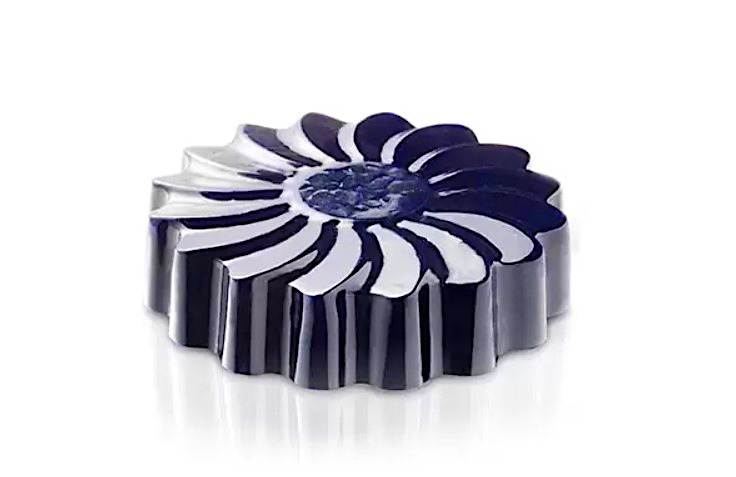
I had a fantastic experience with dual Blue Suns on the wall next to and slightly behind the speakers. Originally, I placed only one Sun there, at the height of the tweeter. The sound became more focused and vocals articulated, at the price of accentuation of S’s and F’s – the sisters became ssisters, the coffee became cofffee, and the cymbals had more sizzle and attracted attention too much. I moved the Suns 10 centimeters higher, which helped but made the sound leaner. Now, read the following carefully: I had one position that negatively enhanced sibilants, and another position that made the sound leaner. Would you intuitively combine those two? Well, when I used the Blue Suns in both the positions simultaneously, one above another, spaced by aforementioned 10 centimeters, both problems disappeared. Instead, I was enjoying wonderfully full-bodied and three-dimensional sound that was addictively sweet and very natural and spacious.
In the next step, I added Black Stones atop the Blue Suns, and the sound smoothened, was less forward, and acquired black velvety quality, as if the sound darkened a bit. I removed the Black Stones and added Blue Diamonds atop the Blue Suns, and everything magically snapped together. I was enjoying sweetly articulated images that were holographically fleshed out in my room, and I could track the singer as she moved her head behind the microphone. Surprisingly, the bass became punchier and weightier too. This combination was a win-win solution. By using the ‘stacking’ method one has a high number of degrees of freedom with the Steinmusic devices - you cannot employ quite the same method with the Synergistic’s HFTs or other similar devices.
Finally, the biggest advantage of the Steinmusic’s devices over the competition is that they never spoil the sound. I have no such experience with the aforementioned competitors, or e.g. Acoustic Revive toolbox. Place a Sugar Cube at a wrong position or a wrong location, and the sound suffers. Use the wrong type of the HFT, and the attractive widening of the soundstage is paid by deterioration of image specificity. I see the ability of the Steinmusic passive devices not to spoil the sound quite unique. With them either you hear nothing, or you hear an improvement. Even my example with enhanced sibilants may be a blessing for some dull and dark sounding systems. If you hear nothing, then you did not work hard enough to find right positions for the devices. If you hear the improvement and are happy, it is the time to employ the active devices.
H2 Harmonizers
Although Suns, Stones, and Diamonds can be used without the H2 Harmonizers, the magnitude of the effect increases quite dramatically with the H2s employed. However, I wanted to isolate the Steinmusic H2s from the passive devices, so I first tested the Harmonizers on their own, that is without the passive support.
In my very first listening session with a pair of the H2s, after 30 minutes of shuffling the Harmonizers behind and next to my loudspeakers, to the left and to the right, closer and farther, I could hear no changes in how the music sounded. I went to the other room, where another two Harmonizers were waiting, thinking that perhaps I needed to add another pair to hear the effect? While switching the other pair in the other room on, I noticed that both the Harmonizers were marked as H2b. Mind you – there is the H2a and the H2b version of the H2, and I knew it because I studied the manual carefully. Still, I somehow managed to place a pair of the two H2a’s in the listening room.
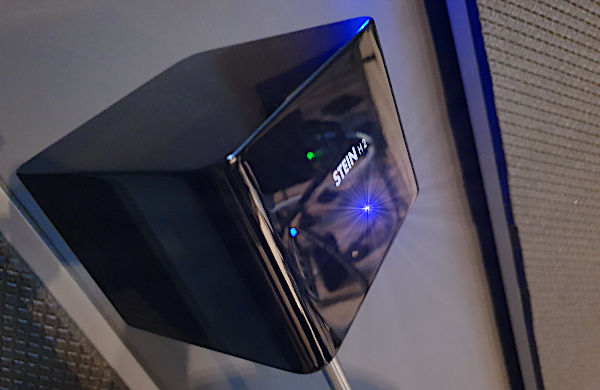
Another 30 minutes of shuffling (now with the correct combination of the units) and I located two ‘best’ positions and marked them with a masking tape on the floor. One was behind the speakers close to the front wall, 15cm from it, the other at approximately 2/3 of the distance towards the speakers. At this point, the H2 units were always diagonally firing across the room. I started playing the beautiful piano and viola duet of Tamestit/Tiberghien (Bellini, Norma, Bel Canto, Harmonia Mundi). The first H2 placement removed the front wall. It did not move it back a feet or two, as reported in some reviews that I read, it erased it. It was not that I could hear better into the ambience of the studio, I was in the studio. The instruments sounded sweeter and became more tangible, as if the reflections from the wall behind the interprets were less suppressed. The other placement, closer to the speakers, resulted into more presence. The instruments got closer to me. Unlike me being transported into the studio, the musicians came to my room. Not bad either! I guess it will be a matter of the listener’s preference – I preferred the be there illusion.
I was encouraged by the result and spent another 2 hours by adding the second pair of the H2 Harmonizers, and fine tuning them. It took me a week of listening to various music material before I settled down on the final placements, final toe-in, and final intensity settings. However, it took me another 2 weeks before I integrated all the Steinmusic’s devices into a synergistic whole.
Weaving the web of lights
In The Mummy movie (1999, Universal Picture), there is a scene of Brendan Fraser entering a pharaoh’s tomb. He shots at a mirror and activates an ancient lighting system, a network of mirrors that connect to each other via correct placement and correct angles. You can check the sequence here: https://www.youtube.com/watch?v=PoJI59K5eAc.
In my opinion you should look at the Steinmusic system as if it was a similar network of mirrors. Which means that one or two mirrors are not enough, to make the system work you need to employ a minimum critical number of Steinmusic devices, placed and oriented at precise locations. My go-to recommendation is two H2 Harmonizers in front of the room, plus at least five Blue Suns on walls, plus one at the ceiling. In my experiments the effect of corner-placed Black Stones was not significant, which may be different for you, of course. This basic network will light up any room. By adding more soundmirrors (or stacking them as mentioned) the acoustic properties of the room’s ambience can be further refined. Beyond certain point, the returns of adding the extra Suns diminish. Getting most of the system means employing at least 2x H2 Harmonizer pairs, and 5 to7 Blue Suns, all properly set. What will you get?
An expansive soundscape, with detailed and focused images in it. This is not the result of inflating the soundstage in your room, rather the result of pushing the walls further apart or erasing them completely.
During the process of dialing in the Steinmusic devices, one by one, the transparency is built layer upon layer. I should perhaps say the noise and hash is removed layer by layer. There is less and less in the way of music, there is more music. The air gets translucent and the images more robust, fleshier. Although timbres of the acoustic instruments are not changed as such, they acquire sheer luminous filled-out beauty, a hint of shimmering sweetness that makes listening very addictive.
The effect of removing room boundaries goes even further with the whole network employed. It feels like the Steinmusic system somehow bends the air in the room, the soundstage virtually wraps around you. It is not unsimilar to cross-talk cancellation; with good recordings, the sounds start to arrive from 3 and 9 o’clock positions. With some recordings, I feel the ambience behind me as if I was listening to a multichannel system. It is not that the sounds are coming from behind my back, they can’t, but the room is felt alive, I can hear the sound grow fainter across the decay, and it has nothing to do with sound reflections.
All things are connected, and tiny adjustments can accumulate into easily discernible improvements. The synergistic effect of the Harmonizers and the Blue Suns has a very positive influence on everything. During the Tamestit viola parts, I can hear more of the friction of the bow on strings. During the Tiberghien piano parts, I can discern much easier the mechanic noise of pedal work, at one moment I can even hear the shoe gently tap the pedal. I hear the voice of Alison Krauss how she inflects words with her teeth and lips, how her tongue comes off her palate as she forms consonants. It is so clear and distinct.
It feels natural that the H2 Harmonizers are the first things to activate. They are active devices and audiophiles like active devices. However, the Stones, Diamonds and Suns are equally (if not more) important for the result. Therefore, I recommend the reversed approach: start with the passive units, and sculpt the sound into the way you like it. Be patient, experiment, evaluate carefully. Only when this is done and your room is transformed into a new one by the passive treatment, add the H2 Harmonizers. They will work like triggers and intensifiers, like a revolver of Brendan Fraser in The Mummy, they let the light enter your listening room.
The demonstration of the Steinmusic Room Acoustics System is easy. Install it, fine tune it, listen for a week, and then remove it. I did it after 2 months. I paused Tchaikovskys’s The Nutcracker suite for several minutes (Valerii Gergiev and Mariinsky Orchestra SACD), removed all the devices from the room, and resumed the playback.
The sound remained great and I was pleased by it – I had worked hard over years to sculpt it into the current shape. Yet, without Steinmusic’s paraphernalia, it lost its vividness, translucent holography, and flow. It felt as if I moved my audio system into an anechoic chamber – the sound became duller and gripped between the walls.
Tips and recommendations
There are few things I wish were improved with the next generation of the Steinmusic devices. And the new generation is coming, as reported by the company, so maybe a good opportunity to address imperfections.
The intensity knobs on the H2 Harmonizers have smooth operation and no markings. It is nearly impossible to recall previous position when working with them. I solved it with a piece of masking tape attached next to them and made pencil marks on the tape during my trials. The solution to this problem is simple – Steinmusic should make the knobs indented, or even better, print fine numbered marks on the housing below the knobs. It could be also solved by providing an attachable plotter-cut template that can be sticked around the knob.
It is interesting that the recommended setting of the intensity knob (somewhere between 9 and 12 o’clock) is confirmed by most reviewers as the optimum one. In my case I ended up with circa 10.30. Makes me wondering - why not to use microswitches instead the knob, covering the settings between 9 and 12. If 9 is the default (the H2 on) it only requires other 6 options with 30’ resolution, which is enough. That way my complaint about the ease of recalling would be solved too.
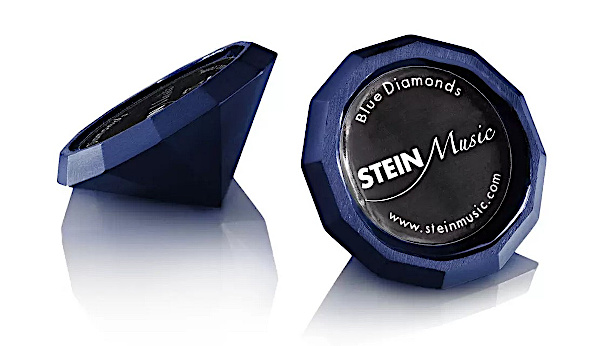
All the Steinmusic units, no matter whether H2s or the passive devices, must be removed from the room if the before/after comparison is to be made. This is not a real downside but keep it in mind when experimenting. I also found that it is much better not to switch the H2s off at all. If you remove them from the room, keep them on, and carry them as far as possible away from your listening space. If you only switch them off in the listening room, you won’t suppress their function entirely. What’s more, if you switch them back on, it will take approximately 30’ before they “heat up” and you enjoy the full effect. They need circa 2 hours to develop even more, and a week to completely blend with environment. Don’t underestimate it.
The H2 Harmonizers are also sensitive to orientation. Don’t ask me why. Small increments/decrements around 45° diagonal toe-in mean changes in the result. Ditto for the Blue Suns, there is a difference in sound in case they are pressed flat against the wall and if they are placed facing up to the ceiling. I mentioned the acrylic holders earlier. I think it is a clever and unobtrusive solution, provided that the holders are secured well on the wall. But the Blue Suns are heavy, especially in when you stack two Signature versions. Although the Black Tack (a plastic non-marking glue) is provided, you need to use big amount of it if the Suns (or their holders) should not detach from the wall and crash to the floor. As soon as you are sure that you have the final locations, use screws to make the placement permanent.
To the owners of HFTs, FEQs, Atmospheres, QR-8 Quartz Resonators, RR-888s, Sugar Cubes, Mpingos, Quantum X2 Stickers, QPoints, and similar accessories: depending on how you employ the Steinmusic devices they may be highly complementary. In my own listening room, I could go way beyond what I thought was possible with the Synergistic Research/ASI units by adding the H2s, the Blue Suns, and the Blue Diamonds. So, despite it is always better to start on a blank canvas, the take-away is: if you already own some of the stuff I mentioned, don’t keep yourself from trying the Steinmusic devices on top of what you have. I guarantee a revelatory journey. However, ff you have the blank canvas and can start from scratch, you will be stunned.
The current pricing is available at Steinmusic' s online shop: https://www.steinmusicstore.com
Contact: Stein Music Pro GmbH, Mülheim an der Ruhr, Germany, + +49 (0)208 32089
(C) Audiodrom 2022
